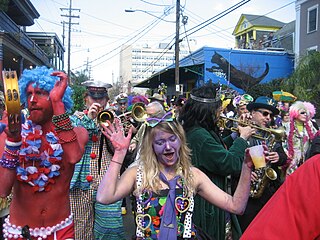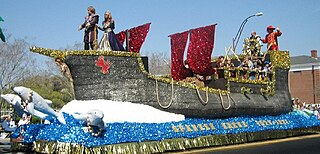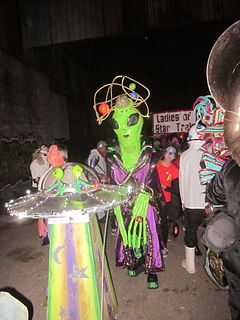Photos of the 2005 OAK parade
 |
 |
 |
 |
The Krewe of OAK is a small neighborhood New Orleans Mardi Gras krewe and parade held in the Carrollton neighborhood of New Orleans, Louisiana. The parade starts and ends on Oak Street, presumably the origin of the name, although members say that OAK stands for "Outrageous And Kinky". [1]
The krewe's Carnival parade is held on the Friday night before Mardi Gras Day. OAK also holds a "Mid Summer Mardi Gras" celebration, usually in August. [2] The Krewe Ball is held at the Maple Leaf Bar, and parades start and end outside that neighborhood landmark.
The Krewe of OAK is an example of neighborhood Carnival celebrations. Since the 1980s it is the only parade still marching in Carrollton during the Carnival season, as the neighborhood's older Krewe, the Krewe of Carrollton, now parades on Saint Charles Avenue and Canal Street, one of the routes which the city government now strongly pressures parades over a certain size to follow.
The parade traditionally features golf cart floats with effigy heads of notable Carrollton characters, including James Booker. Additionally, there are jazz brass bands, dance troupes, and home-made floats and costumes.
The 2005 Krewe of OAK Midsummer Mardi Gras Parade on Saturday night, 27 August 2005, was the last parade held in New Orleans before Hurricane Katrina.
The annual Krewe of OAK Mid-Summer Mardi Gras parade usually takes place on the last weekend of August. But in 2017 the foot parade was held on the second to last weekend of August in order to better coincide with the upcoming solar eclipse.
 |
 |
 |
 |

Mardi Gras, or Fat Tuesday, refers to events of the Carnival celebration, beginning on or after the Christian feasts of the Epiphany and culminating on the day before Ash Wednesday, which is known as Shrove Tuesday. Mardi Gras is French for "Fat Tuesday", reflecting the practice of the last night of eating rich, fatty foods before the ritual Lenten sacrifices and fasting of the Lenten season.

A krewe is a social organization that puts on a parade or ball for the Carnival season. The term is best known for its association with Mardi Gras celebrations in New Orleans, but is also used in other Carnival celebrations around the Gulf of Mexico, such as the Gasparilla Pirate Festival in Tampa, Florida, Springtime Tallahassee, and Krewe of Amalee in DeLand, Fl with the Mardi Gras on Mainstreet Parade as well as in La Crosse, Wisconsin and at the Saint Paul Winter Carnival.
The Mistick Krewe of Comus, founded in 1856, is a New Orleans, Louisiana, Carnival krewe. It is the oldest continuous organization of New Orleans Mardi Gras festivities.
Rex is a New Orleans Carnival Krewe which stages one of the city's most celebrated parades on Mardi Gras Day. Rex is Latin for "King", and Rex reigns as "The King of Carnival".

The holiday of Mardi Gras is celebrated in all of Louisiana, including the city of New Orleans. Celebrations are concentrated for about two weeks before and through Shrove Tuesday, the day before Ash Wednesday. Usually there is one major parade each day ; many days have several large parades. The largest and most elaborate parades take place the last five days of the Mardi Gras season. In the final week, many events occur throughout New Orleans and surrounding communities, including parades and balls.
The French Quarter neighborhood of New Orleans, Louisiana is the center of the city's Carnival celebrations, especially on Mardi Gras Day. This part of town is crowded with both tourists and locals, with the former more numerous in the Upper Quarter, the latter in the Lower Quarter. There are numerous parties and more than one costume contest. While the large motorized floats of the big parades have been prohibited since the early 1970s from going down the Quarter's narrow streets, numerous small marching krewes, parading jazz bands, and groups of revelers converge here. Some krewes parade in the Quarter after starting earlier in the day in other parts of town.
The Krewe of Endymion is a New Orleans Mardi Gras super krewe and social organization.
Carnival Memphis, is a series of parties and festivities staged annually since 1931 in Memphis, Tennessee by the centralized Carnival Memphis Association and its member krewes during the month of June. Carnival salutes various aspects of Memphis and its industries, and is reigned over by the current year's secretly selected King, Queen, and Royal Court of Carnival.
The Half-Fast Walking Club is a New Orleans Mardi Gras krewe founded and historically led by Pete Fountain, until his passing on August 6, 2016. Originally all on foot, in recent decades it has also featured one or two small floats. Fountain and other local jazz musicians played through much of the parade. The krewe's current route, basically unchanged since the mid-1970s, starts at 7 AM on Mardi Gras morning, at world-famous Commander's Palace Restaurant on Washington Avenue in the Garden District. The krewe then proceeds downtown on St. Charles Avenue and after a brief interlude on Canal Street, enters the French Quarter at Bourbon Street, winds around the Quarter and eventually ends up at the Monteleone Hotel in the early afternoon.
Krewe of Tucks is a New Orleans Mardi Gras krewe.

Lundi Gras is a relatively recently popularized name for a series of Shrove Monday events taking place during the Mardi Gras. It includes the tradition of Rex, king of the New Orleans carnival,and Zulu King arriving by boat. This began in 1874, but the term Lundi Gras was not widely applied until 1987 when the arrival was brought back as part of a series of river-related events under the name of "Lundi Gras". Lundi Gras was the creation of journalist Errol Laborde. The event was staged with the cooperation of Riverwalk Marketplace and its then marketing director Carol Thistle Lentz. The events are detailed in Laborde's book, Krewe: The Early New Orleans Carnival from Comus to Zulu.

Mardi Gras is the annual Carnival celebration in Mobile, Alabama. It is the oldest annual Carnival celebration in the United States, started by Frenchman Nicholas Langlois in 1703 when Mobile was the capital of Louisiana. This was fifteen years before New Orleans was founded, although today their celebrations are much more widely known for all the current traditions such as masked balls, parades, floats and throws were first created there. From Mobile being the first capital of French Louisiana (1702), the festival began as a French Catholic tradition. Mardi Gras in Mobile has now evolved into a mainstream multi-week celebration across the spectrum of cultures in Mobile, becoming school holidays for the final Monday and Tuesday, regardless of religious affiliation.

The Krewe of Muses is an all-female super krewe and social organization.

A mystic society is a Mardi Gras social organization in Mobile, Alabama, that presents parades and/or balls for the enjoyment of its members, guests, and the public. The New Orleans Krewe is patterned after Mobile's Mystics. The societies have been based in class, economic and racial groups. Mobile's parading mystic societies build colorful Carnival floats and create costumes around each year's themes.

Mardi Gras in the United States is not observed nationally across the country, largely due to the country’s Protestant and Anglo roots. Mardi Gras and Carnival are mostly Catholic holidays, while the United States has a Protestant majority population. However, a number of cities and regions in the U.S. have notable Mardi Gras or Carnival celebrations. Most of these places trace their Mardi Gras celebrations to French, Spanish, and other Catholic colonial influences on the settlements over their history. The earliest Carnival celebration in North America occurred at a place on the west bank of the Mississippi river about 60 miles downriver from where New Orleans is today; this Mardi Gras on the 3rd of March 1699 and in honor of this holiday, Pierre Le Moyne, Sieur d'Iberville, a 38-year-old French Canadian, named the spot Point du Mardi Gras near Fort Jackson. The earliest organized Carnival celebrations occurred in Mobile, Biloxi, New Orleans, and Pensacola, which have each developed separate traditions. In addition, modern activities generally vary from city to city across the U.S.

The Krewe du Vieux is a New Orleans Mardi Gras krewe more fully known as the Krewe du Vieux Carré.

The Intergalactic Krewe of Chewbacchus is a science fiction–themed Mardi Gras krewe, or parade organization, that also features fantasy and horror groups, among other fandoms. Based in New Orleans, Louisiana, as of the 2019 parade, the Intergalactic Krewe of Chewbacchus has over 2500 dues-paying members who call themselves "ChewbacchanALIENs" or "Chewbs."
Krewe of Carrollton is a New Orleans Mardi Gras krewe.
The Mystic Krewe of Nyx is an all-female Carnival Krewe organization, based in New Orleans, which was organized and founded by Julie Lea in 2011. The Nyx's first pageant, "NOLA Reality Reigns," was featured on the St. Charles Avenue Parade Route on February 15, 2012. The Mystic Krewe of Nyx is named after the Greek goddess of the night, Nyx.

The Krewe of Cleopatra is an all female krewe and social organization.